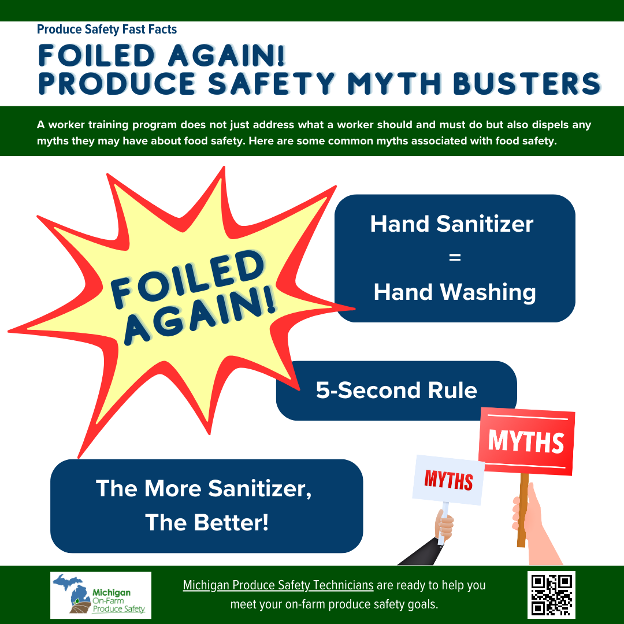Foiled Again! Produce Safety Myth Busters
Micah Hutchison, Produce Safety Technician
Landen Tetil, Produce Safety Technician
An essential part of a training program is not just addressing what a worker should and must do but also dispelling any myths they may have about food safety. Here are some common myths associated with food safety you can add to your training program.

Foiled Again! Produce Safety Myth Busters
Well-trained employees are an essential part of your farm’s food safety culture. Training programs often cover the “dos and don’ts” of the job and prepare workers to be successful in their roles. An essential part of a training program is not just addressing what a worker should and must do but also dispelling any myths they may have about food safety. Here are some common myths associated with food safety you can add to your training program.
MYTH #1
The 5-Second Rule…We know, we know. While we hate to burst your bubble with this one right out of the gate…there’s no such thing as the “5-second rule.” When covered produce unintentionally drops to the ground during growing, harvesting, or packing activities, leave it where it falls. Dropped produce can become contaminated with pathogens and is unsafe for fresh consumption.
MYTH #2
Hand sanitizer is as good as handwashing! While using hand sanitizer as a replacement for handwashing is better than not doing anything, it really isn’t an acceptable way to clean your hands, especially in a food-contact setting, such as harvesting produce, washing produce, and packing produce. Hand sanitizer becomes bound to organic matter present on your hands, including dirt and the natural oils on your skin. This makes the hand sanitizer ineffective and leaves you with unclean hands. Hand washing with soap removes this layer of organic matter and is incredibly effective at eliminating harmful bacteria. If hand washing occurs first, it is perfectly acceptable (though not required) to follow up with hand sanitizer - and it will allow hand sanitizer to actually do its job!
Bonus! Myth #2.5
It’s OK to sanitize food-contact surfaces without cleaning first. You can’t sanitize a dirty surface! A cleaning step - involving a food-grade detergent and elbow grease - needs to happen before any sanitizing spray step. Even if a surface looks visibly clean, there may still be biofilms and bacteria on the surface, and a sanitizer alone can’t do the job of removing those. We’ll say it again, you can’t sanitize a dirty surface!
MYTH #3
More (sanitizer) is better! When it comes to sanitizers, the label is law. First, any sanitizer used on food contact surfaces or in produce wash water MUST be labeled for that use. Second, the sanitizer you choose MUST be mixed and diluted to the proper strength according to the label. Need a hand in deciphering sanitizer labels? Your local Produce Safety Technician would be happy to help, or reference Produce Safety Alliance’s guide to selecting a sanitizer.
Myth #4
Just throw it in the compost pile! On-farm composting is a great solution to vegetative waste and improving soil quality. If composting on-farm you MUST use a scientifically- validated method and keep records. MIOFPS.org has a great reference on Safe and Successful Composting and other useful information on composting. As always, your local Produce Safety Technician can assist you with record keeping templates and answer any questions you may have.
Want more myth-busters?
The Michigan On-Farm Produce Safety team is ready to answer your food safety questions.
Michigan Produce Safety Technicians are ready to help you meet your on-farm produce safety goals. We will work with you to identify, manage, and minimize risks to food safety on your farm, and help you create a comprehensive food safety plan to prepare you for a MI Produce Safety Risk Assessment Certificate. Working with Produce Safety Technicians is always free and confidential, and there is no cost to apply for the certificate. Scan or click the QR code to get started. Visit miofps.org to get started!



 Print
Print Email
Email